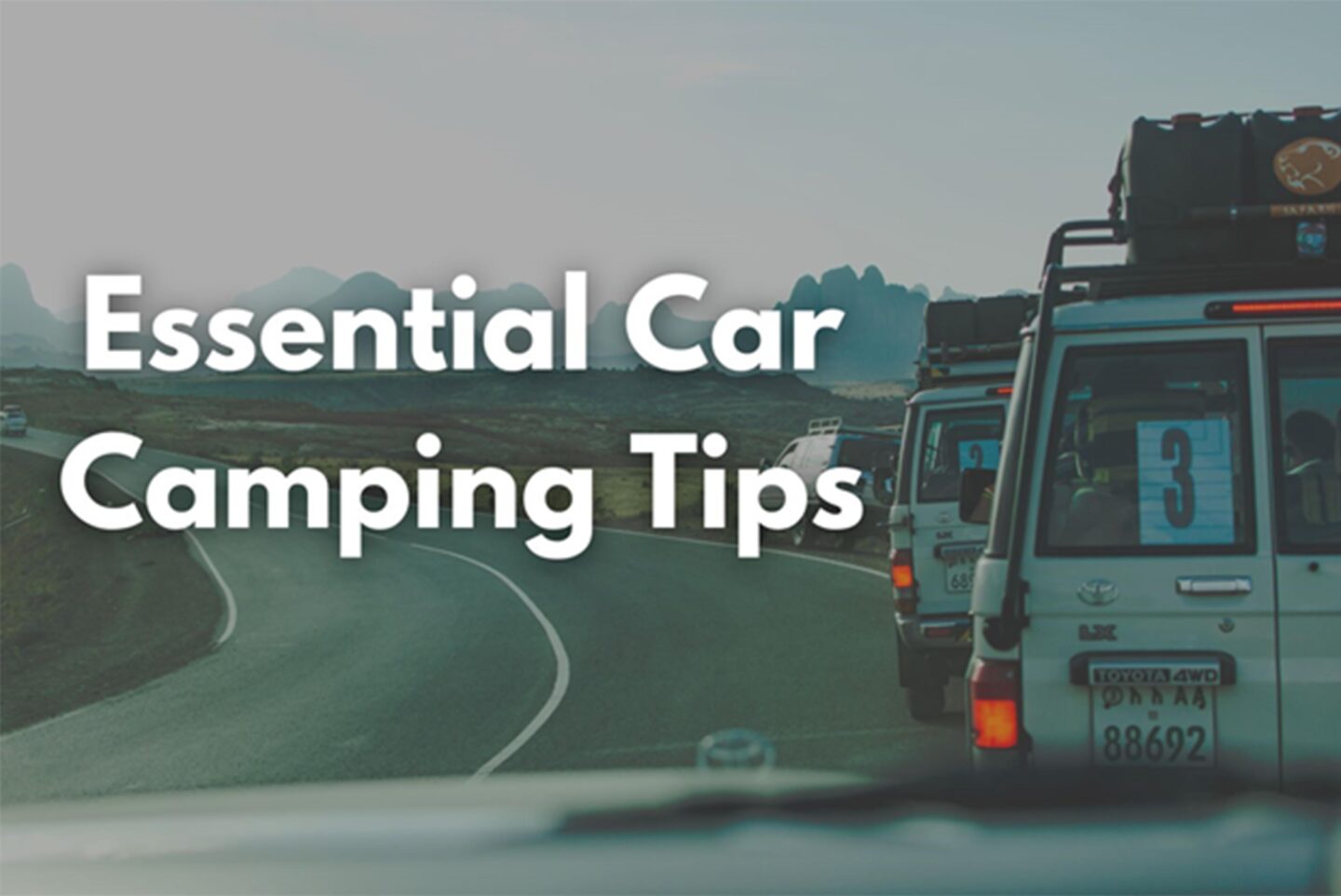
For those seeking adventure on the open road, car camping allows you to explore nature’s beauty with the freedom and convenience of having your own set of wheels. If you’re a first-timer, the idea can be exciting and daunting. It provides tips and tricks for first-time car campers, such as selecting the right site, packing, staying organized, and maintaining ethical standards.
In this 101 guide, you’ll learn everything you need to know before camping for the first time. Let’s head out armed with the know-how for an epic first-car camping trip, whether you’re solo, with family, or with friends. So that you avoid making rookie mistakes, I will soak up some sage advice.
Key Takeaways:
- Convenience is one of the main attractions of car camping, providing easy access to road trips and essential car emergency kits.
- Comfort is key in car camping, with essential items such as sleeping bags, air mattresses, and pillows ensuring a good night’s rest.
- Affordability is a major benefit of car camping, with reasonably priced equipment and the option to use affiliate links to save on additional costs.
What is Car Camping?
Car camping is a form of camping in which individuals set up their own tent or sleep in their vehicles at designated campsites. By doing this, your car is easily accessible for supplies, and you can enjoy camping while having your vehicle nearby for shelter, storage, and transportation.
Packaging versatile gear, such as a multi-fuel stove and compact cooking equipment, is advised for car camping. Set up your campsite as close as possible to your vehicle for ease of access to supplies.
Why Go Car Camping?
As a popular means of exploring the great outdoors, car camping offers the convenience of having your own transportation and the flexibility to travel without having to worry about accommodation. During this section, we will discuss the top three reasons why car camping is an excellent choice for your next adventure.
A car camping trip has something for everyone, from the convenience of having an emergency kit in the car to the comfort of a cozy sleeping setup to the affordability of an affordable trip with additional cost-saving tips. The following points will explain why it is a good idea to go car camping next time.
1. Convenience
Pack essentials: Bring a tent, sleeping bags, and camping chairs for a comfortable setup.
Cooking supplies: Prepare easy-to-make meals, like sandwiches and salads, or use a portable stove for hot meals.
Emergency kit: Equip your car with basic tools, a first aid kit, and emergency supplies for unforeseen situations.
Make your car camping experience as convenient and stress-free as possible by packing efficiently and having a well-stocked car emergency kit.
2. Comfort
- Choose a comfortable sleeping bag or air mattress to ensure a good night’s sleep.
- Consider using a sleeping pad or foam mattress for added cushioning and insulation.
- Bring a pillow to support your head and neck for a restful sleep.
Sleep quality can significantly improve while camping in a vehicle with a quality sleeping bag or air mattress.
3. Affordability
- Choose campsites with reasonably priced or free permits to reduce additional costs.
- Invest in durable gear to avoid frequent replacements, saving money in the long run.
- Consider using affiliate links to purchase camping supplies and earn rewards or discounts.
- Also, check out some essential car maintenance tips to ensure your vehicle is ready for the journey, adding to the affordability by avoiding costly repairs
Car camping can be as much as 50% less expensive than staying in a hotel, making it a cost-effective method of exploring the outdoors.
What to Pack for Car Camping?
Having your vehicle nearby to store all your essentials is a great benefit of car camping, but it is essential to pack wisely to maximize your camping experience. Our purpose in this section is to provide information regarding what to pack for car camping, including the essential items you will require for a comfortable and enjoyable vacation.
Whether you plan to camp this summer or next year, I will cover everything you need to know before you hit the road.
1. Tent and Sleeping Gear
- Choose a tent suitable for the number of campers and the weather conditions, such as a waterproof tent for rainy climates.
- Be sure to bring sleeping bags, pads, and pillows for a comfortable rest.
- Also, consider packing a portable camping hammock for relaxation during the day.
2. Cooking Supplies
When packing for car camping, essential cooking supplies include:
- a portable stove
- a cooler
- a cook set
- dishware
- a coffee maker
Besides the stove, a cooler will ensure your food remains fresh while camping. Furthermore, you will need a cookware set with various utensils for making meals and dishware for serving them. Finally, a coffee maker will enable you to make your favorite brew when under the stars.
3. Clothing and Personal Items
- Pack weather-appropriate clothing, including rain gear, for varying conditions.
- Include personal items such as toiletries, medications, and personal hygiene products.
- Carry bug spray and sunscreen to protect against insects and sun exposure.
- Use backpacks or daypacks to carry essentials for day hikes or short trips from the campsite.
4. First Aid Kit and Emergency Supplies
- Stock a comprehensive first-aid kit with bandages, antiseptic wipes, pain relievers, and any necessary medications.
- Prepare a car emergency kit containing items such as jumper cables, a flashlight, blankets, and non-perishable food.
- Reflect on past experiences to identify valuable lessons learned and ensure you’re better equipped for future car camping trips.
How to Choose the Right Campsite?
Choosing the right campsite for your car camping adventure can have a significant impact on the enjoyment and quality of your experience. This section discusses key factors to consider when selecting a campsite, including location, amenities, and regulations and rules.
Keeping these factors in mind will ensure a comfortable and enjoyable camping experience in your vehicle. Here are some tips for locating the ideal location for setting up a spacious tent and solid camp setup.
1. Location
Research the location: Look for car camping-friendly spots that offer diverse outdoor adventure opportunities and align with your interests. Consider local adventurer blogs or forums for hidden gems.
Check for proximity: Ensure the chosen location is within a reasonable distance to minimize travel time and maximize your car camping experience.
Review accessibility: Confirm that the location is accessible by car and offers suitable parking facilities for a convenient car camping trip.
When seeking the perfect location for car camping, prioritize accessibility, proximity, and adventure potential.
2. Amenities
- Spacious Tent: Look for a tent with ample room to accommodate your group comfortably.
- Solid Setup: Prioritize a campsite offering sturdy picnic tables, fire pits, and clean restroom facilities.
- Amenities: Seek campsites with desirable features such as potable water, showers, and electricity hookups.
A friend once shared a car camping experience where they found a campsite with exceptional amenities, a spacious tent area, and a solid setup, making their trip incredibly enjoyable and hassle-free.
3. Rules and Regulations
- Check the specific rules and regulations of the campsite for both car camping and tent camping.
- Ensure compliance with any restrictions on activities, noise, waste disposal, and campfire usage.
- Respect the designated quiet hours and follow any pet policies if applicable.
What are Some Essential Car Camping Tips?
Before you hit the road on your next camping trip, it is important to know some essential tips that will ensure a successful and enjoyable experience. Our focus will be on the top five tips for car camping in this section, including planning and preparation, packing smartly with updated essentials, staying organized at the campsite, being aware of your surroundings to ensure a peaceful night’s sleep, and preserving the natural beauty of the backcountry. Let’s dive in and get you ready for your car camping trip!
1. Plan and Prepare
- Research your destination and check for any necessary permits or reservations for your next camping trip.
- Create a detailed packing list, including camping gear, food, and clothing, to make sure you have everything you need.
- Check and prepare your car, ensuring it’s in good condition for your upcoming trip, and read tips on an expert automobile blog.
- You should plan your tour and familiarize yourself with the layout and facilities of the campsite you will be visiting.
- Inform someone of your camping plans and expected return date for safety.
Before your next car camping trip, take the time to plan and prepare to ensure a smooth and enjoyable outdoor adventure. With proper organization and foresight, your next camping experience can be both convenient and memorable.
2. Pack Smart
- Create an updated camping checklist to ensure you pack all essential items.
- Pack versatile clothing suitable for various weather conditions.
- Organize items in labeled containers for easy access.
- Opt for lightweight and compact gear to save space.
- Include multipurpose tools like a Swiss army knife.
A friend once went car camping and forgot to pack their tent. They ended up fashioning a makeshift shelter using a tarp and some ropes, turning it into a memorable camping experience.
3. Stay Organized
- Utilize storage containers and organizers specifically designed for car camping to keep your gear neatly arranged.
- Implement a designated area for each item to ensure easy access and prevent misplacement.
- Create a checklist for every car camping trip to streamline the packing process and minimize the risk of forgetting essential items.
4. Be Mindful of Your Surroundings
- Be aware of wildlife and potential hazards in the area.
- Respect the natural environment and avoid disturbing the ecosystem.
- Minimize noise pollution, especially during the night, to ensure a peaceful night’s rest for fellow campers.
Remember to take some time to stargaze and enjoy the beauty of the Milky Way, but always be mindful of the impact on the surroundings.
5. Leave No Trace
- Dispose of waste properly, including food scraps, to avoid attracting wildlife.
- Minimize backcountry camping impacts, using established fire rings where possible and keeping fires small.
- Leave what you find, preserving the natural environment and not disturbing vegetation or wildlife.
- Respect wildlife by observing from a distance and not feeding animals.
- Be considerate of other visitors, keeping noise levels down and giving them space.
It is recommended that backcountry campers practice Leave No Trace principles to minimize their negative impact on the environment as well as promote responsible outdoor behavior.
Conclusion:
For car campers, this guide covers the key bases for first-time car campers – from packing smart to choosing a site and being prepared for anything on the road. Follow the tips on convenience, comfort, and responsibility to avoid rookie pitfalls. Soon, you’ll be fireside under the stars after an exciting day of adventure before a good night’s sleep in your tent.
With helpful advice, you now have everything you need to hit the open highway in your set of wheels for a unique, memorable camping trip. Now is the time to answer the call of the great outdoors and enjoy the freedom of car camping. Gear up and begin your epic car camping adventure.
Related Articles:
– 10 Things to Know Before You Retire
– Everything You Need to Know About Travelling

